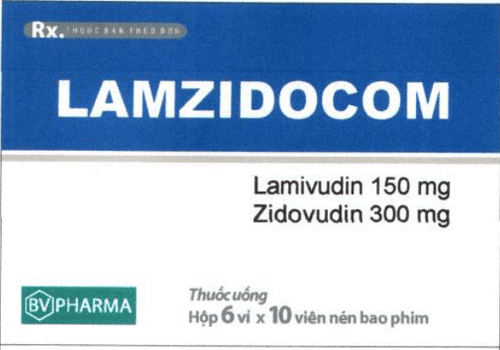This is an automatically translated article.
Lamzidivir is used to treat HIV infection causing immunodeficiency in people 12 years of age and older. The drug has the main ingredients Lamivudine and Zidovudine. Let's learn more about Lamzidivir drug line through the article below.
1. What is Lamzidivir?
Lamzidivi belongs to the group of drugs that treat parasites, anti-infectives, antivirals, and antifungals. The drug is prepared in the form of film-coated tablets packed in a box of 6 blisters X 10 and a box of 1 bottle of 60 film-coated tablets.
Lamzidivi drug has the main ingredients Lamivudine and Zidovudine and other excipients.
2. What does Lamzidivir do?
2.1. Effect of Lamivudine and Zidovudine Active ingredient Lamivudine has strong virus killing ability, high killing hepatitis B virus in all tested cell lines and infected laboratory animals.
The active ingredient Zidovudine has strong antiviral activity, including anti-HIV. The effect of Zidovudine is due to the ability to phosphorylate by the enzyme Thymidine kinase of the cell. Phosphorylation occurs twice to produce the triphosphate derivative of Zidovudine, which competes with the DNA synthesis enzymes of HIV virus cells to prevent DNA strand formation, ending the strand immediately, so that the virus not aggregated.
2.2. Indications for use of Lamzidivir Drug Lamzidivir is used in the following cases:
Support to strengthen the immune system for HIV-infected patients. Treatment of HIV infection in adults and children 12 years of age and older, increasing immunity and reducing mortality.
3. Dosage, how to use Lamzidivir
How to use:
Lamzidivir is used orally. Lamzidivir should be taken with plenty of water and can be taken with or without food. Lamzidivir is often used in combination therapy with other antiretroviral agents, so the dose of Lamzidivir may need to be adjusted according to the patient's response. Dosage:
Adults and children > 12 years old with weight over 30kg: take 2 times/day x 1 tablet of Lamzidivir/time. Children 21 to 30 kg: half a Lamzidivir tablet/morning, and 1 Lamzidivir tablet/evening. Children 14 to 21 kg: 1 Lamzidivir tablet/day, divided into 2 times in the morning and evening. Children < 14 kg weight: Lamzidivir should not be used because the dose of Lamzidivir cannot be adjusted appropriately for the weight of the child. The dose of Lamzidivir can be adjusted based on each subject's response and as directed by the physician. Dosage of Lamzidivir will depend on each subject and the patient should strictly follow the instructions prescribed on the doctor's prescription, the pharmacist recommends.
How to handle missed dose, Lamzidivir overdose
Missed dose: In case of missed dose of Lamzidivir, take the medicine when you remember it as soon as possible. However, when it is almost time for your next Lamzidivir dose, skip the missed dose and continue taking your Lamzidivir at your usual schedule. Do not increase the dose on your own or use a double dose of Lamzidivir to make up for the missed dose. Overdose: There are currently no well-reported data on cases of overdose with Lamzidivir. No specific acute symptoms or signs have been identified following an overdose of Lamzidivir, other than those listed as adverse events, and no deaths have occurred. However, it is advisable to monitor the patient for toxicity, apply symptomatic treatment and contact the doctor or the nearest medical center if accidentally overdosed Lamzidivir.
4. Contraindications to use Lamzidivir
Lamzidivir should not be used in the following cases:
Patients with hypersensitivity to Lamivudine and Zidovudine or to any of the ingredients in the drug. Children under 12 years old. The patient has an abnormally low neutrophil count (<0.75 x 109 cells/L), or an abnormally low hemoglobin level (<7.5 g/dL or 4.65 mmol/L).
5. Lamzidivir drug interactions
Here is a list of medicines to avoid in combination with Lamzidivir:
Avoid taking Lamzidivir with Ribavirin or Stavudin. Concomitant use of Zidovudine with UGT inducers or inhibitors may alter the absorption and effects of the drug. Because the active substance Zidovudine is metabolized mainly by the enzyme UGT. Co-administration of Lamzidivir with nephrotoxic drugs or OCT inhibitors may decrease elimination and increase the risk of Lamzidivir toxicity. This is because Lamivudine is actively eliminated by the kidneys, by means of cation transporters (OCTs). Lamzidivir affects the P450 enzyme system in the liver. Therefore, there is little possibility of Lamzidivir interaction with other drugs metabolised by P450 enzymes. Before using Lamzidivir for treatment, patients should inform their doctor/pharmacist of any history of drug allergies or drugs they are and intend to use to minimize possible drug interactions. Lamzidivir drug interactions with preparations such as alcohol, beer, tobacco, stimulants can cause increased adverse effects on the nervous system. Zidovudine alters the blood concentration of Phenytoin depending on the patient. Therefore, attention should be paid to monitoring when appointing patients to use a combination of Phenytoin with Lamivudine and Zidovudine. With Paracetamol combined with Lamzidivir can increase the rate of neutrophils, especially in the case of chronic disease treatment. However, Paracetamol did not increase the metabolism and plasma glucuronic concentrations of Zidovudine. Other drugs that can cause drug interactions with Lamzidivir include: Aspirin, Indomethacin, Codeine, Morphine, Ketoprofen, Naproxen, Oxazepam, Cimetidine, Lorazepam, Clofibrat, Dapson and Isoprinosin. Careful consideration should be given to the possibility of Lamzidivir interactions with the above drugs in case the combination is indicated for long-term treatment. The most common indication is when using Lamzidivir in case of acute treatment with nephrotoxic drugs such as Dapson, Pyrimethamine insecticide, Cotrimoxazol, Flucytosin, Amphotericin, Ganciclovir, Interferon, Vincristin, Vinblastin, Doxorubicin. increased risk of blocking the action of zidovudine. If it is necessary to combine therapy with Lamivudine and Zidovudine with the above drugs, it is necessary to monitor renal function, hematological indicators for the patient. The dose of one or more of the prescribed drugs may be reduced if necessary. Zidovudine has in vitro contrasting effects with Stadvudin and Ribavirin. Therefore, the combination of Lamzidivir with Ribavirin or Stadvudin should be avoided. Patients using Lamzidivir can still get opportunistic infections, which can be combined with antibacterial drugs such as Acyclovir, Cotrimoxazol, and Pyrimethamine for prophylaxis. Clinical data show that there is no indication that the drugs Acyclovir, Cotrimoxazole, Pyrimethamine increase the risk of blocking the action of Zidovudine.
6. Side effects when taking Lamzidivir
During the use of Lamzidivir, patients may experience some unwanted side effects such as:
Whole body: Redistribution or accumulation of fat in the body. Cardiovascular: Cardiomyopathy. Endocrine and metabolic: Hyperglycemia, gynecomastia in men. Gastrointestinal tract: Stomatitis, oral mucosal pigmentation. General: Vasculitis, weakness. Lymphatic and blood vessels: Anemia, stopped growing red blood cells, progressive anemia, lymphadenopathy, splenomegaly. Liver and pancreas: Fatty liver, lactic acidosis, pancreatitis, exacerbation of hepatitis B after treatment. Hypersensitivity: Hypersensitivity reactions, hypersensitivity, urticaria. Skeletal muscle: CPK increase, muscle weakness, rhabdomyolysis. Neurological: Epilepsy, paresthesia, peripheral neuropathy. Respiratory: Abnormal breathing and wheezing. Skin: Stevens-Johnson syndrome, alopecia, erythema multiforme.
7. Precautions when using Lamzidivir
Before using Lamzidivir for treatment, patients should note some of the following:
Use Lamzidivir with caution in patients with liver disease, cirrhosis due to chronic hepatitis B and kidney failure. Use in pregnant women: Using Lamzidivir to treat HIV infection in pregnant women may help reduce the risk of transmission to the newborn. Large amounts of data on pregnant women taking dual active ingredients zidovudine or lamivudine show no malformative toxicity. However, a potential adverse effect with Lamzidivir cannot be excluded. Consult your doctor when using Lamzidivir in pregnant women. Lactation: Both lamivudine and zidovudine are excreted in human milk at concentrations similar to those in plasma. There are no data available on the safety of Lamzidivir when used in children younger than 3 months of age. When a mother is infected with HIV, she should not breastfeed under any circumstances to avoid transmitting HIV to her baby. No reports of the use of Lamzidivir affecting the ability to drive and use machines have been made. However, Lamzidivir can cause fatigue, dizziness and drowsiness. Patients should not drive, operate machinery or perform other potentially hazardous jobs while taking Lamzidivir. Separate preparations of Zidovudine and Lamivudine should be used in cases where dosage adjustment is required. Concomitant use of Zidovudine and Stavudine should be avoided. The antiviral drug Lamzidivir cannot completely eliminate the risk of sexual transmission. Patients should take precautions to prevent transmission of the disease. Store Lamzidivir in a tightly closed container, in a cool, dry place, away from light. Above is information about uses, dosage and precautions when using Lamzidivir. To ensure safety for your health and maximize the effectiveness of your treatment, you need to take Lamzidivir exactly as directed by your doctor.
Please dial HOTLINE for more information or register for an appointment HERE. Download MyVinmec app to make appointments faster and to manage your bookings easily.













